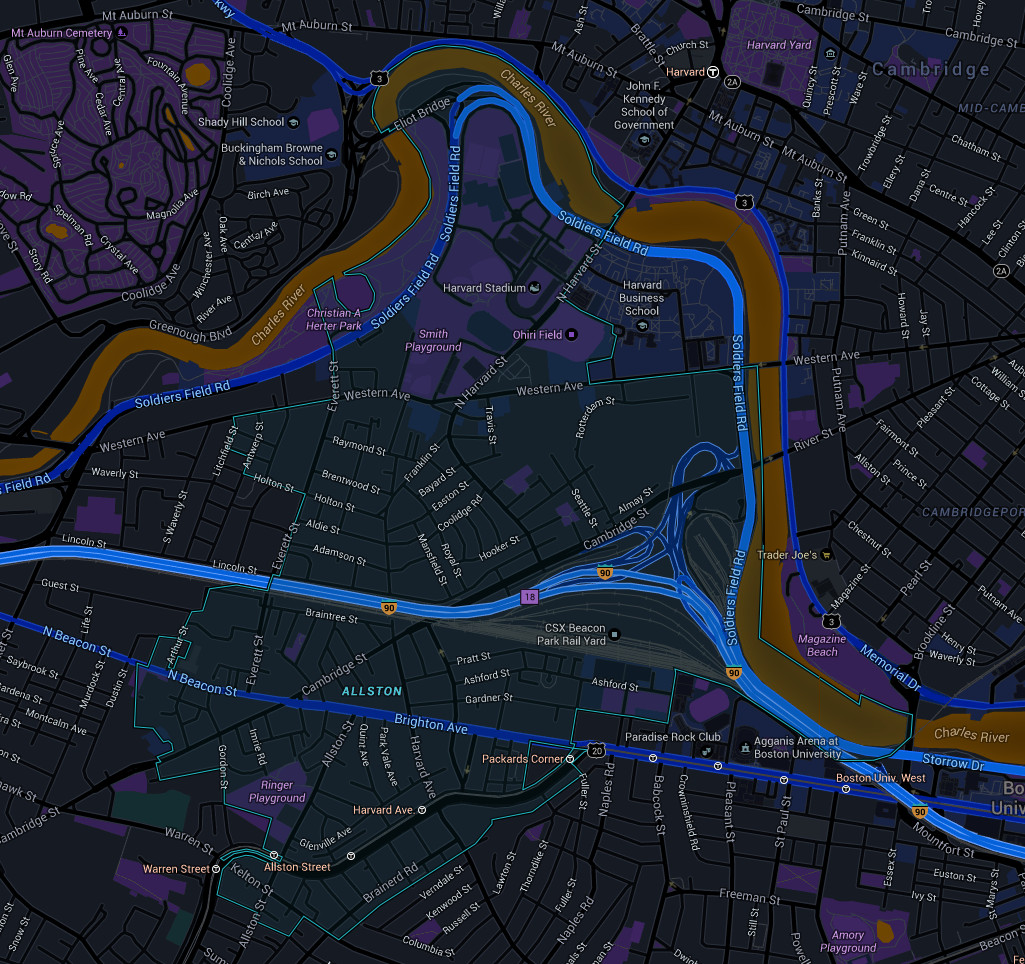Allston
Description
The neighborhood of Allston is almost completely cut off from the main body of the city of Boston by the town of Brookline, which borders Allston on the south and east. It is connected to the rest of Boston only by a small portion of its eastern border that is shared with the Fenway/Kenmore neighborhood. Allston is bordered by the Charles River, separating it from the city of Cambridge to the north, and is split in two by the Massachusetts Turnpike.
The area north of the turnpike near the river is often referred to as "Lower Allston" (referring to its lower elevation) or "North Allston." It consists of streets north of Cambridge Street and the Turnpike, all the way to the Charles River. It extends westward to Everett Street and eastward to Windom Street.
Lower Allston is a small neighborhood that consists of a mix of working professionals, homeowners, and long-term residents. Unlike the rest of Allston, Lower Allston has many fewer students. The neighborhood is very quiet, has extremely low crime, and is an easy walk to Allston Village or Harvard Square.
Lower Allston has close proximity to Route 2, the Mass Pike, Storrow Drive, and Soldier's Field Road. Public transportation includes the Red Line at Harvard Square, the Green Line at Packard's Corner or Harvard Avenue and Commonwealth Avenue in "upper Allston", and the 57, 66, 70, 71, and 86 bus connections on North Harvard Street and Western Avenue are about a 2-5 minute walk for everyone.
In the early 21st century, Harvard University announced dramatic expansion plans that called for major building projects, including the demolition of existing businesses, to prepare for the construction of new biology and science buildings in the northern sections of Lower Allston. While the existing building stock was demolished and businesses were evicted, the financial crisis of 2008 and the resultant decrease in Harvard's endowment caused the university to suspend the expansion projects.
History
Allston was an eastern section of the former town of Brighton.
In 1867 a new railroad depot for the Boston and Albany railroad opened. In 1868 the station and post office in Brighton's eastern portion were given the name "Allston" after Washington Allston, the noted painter who had lived and worked across the Charles River in the Cambridgeport section of Cambridge. It can even be said to have been named for a specific painting: Washington Allston's "Fields West of Boston".
Allston has never existed as a separate political entity in its own right. The Town of Brighton was annexed by the City of Boston in 1874. Henry Wadsworth Longfellow owned several properties in Allston. In 1887 the wooden depot was replaced by a stone station. In 1888 Boston's first trolley route began there, running a route through Coolidge Corner, Brookline, to Boylston Street, to downtown Boston.
The Allston community developed largely around large railroad and livestock operations. The Boston and Albany Railroad (now CSX) operated a major yard. Stockyards and a large abattoir operated nearby in the northern part of Brighton. Much of the railroad yard remains in use today as the CSX Transportation Beacon Park Yard, but all livestock activity ended by the mid-20th century. CSX plans to move its yard operation west, allowing the plot to be redeveloped by Harvard.
A strip running from Brighton Avenue in Allston out Commonwealth Avenue toward Kenmore Square was Boston's original "Automile", lined with automobile dealerships. Packard's Sales Stable and Riding School gave Packard's Corner its name, which was then perpetuated by the presence of an opulent Packard dealership. Only a Toyota dealer and a Vespa dealer remain, but the windowed buildings along the eastern end of Brighton Avenue reflect this history.
The Massachusetts Turnpike Extension, built largely on part of the Boston and Albany right-of-way, opened through Allston in 1964 and 1965.
Culture
Allston is home to numerous small businesses and restaurants. Brighton Avenue, between Packard's Corner and Allston Street, boasts various ethnic and national cuisines from around the world. Harvard Avenue hosts a number of furniture stores, thrift shops, and stores that offer items for resale, due to the large student body and high residential turnover.
The section of the neighborhood that lies immediately south of the turnpike and centers on the stretch of Harvard Avenue between Commonwealth Avenue and Cambridge Street also houses many shops, bars, and restaurants. Recent business promotion initiatives have dubbed this area "Allston Village".
Sub-Districts
- -- Allston Village
- -- Brighton Center
- -- Chestnut Hill
- -- Cleveland Circle
- -- Harvard Stadium/Charlesview
- -- Union Square
- -- Oak Square
- -- Faneuil Square
- -- Brighton Mills
- -- Lower Allston
- -- North Brighton
- -- Packard's Corner
- -- Soldier's Field
